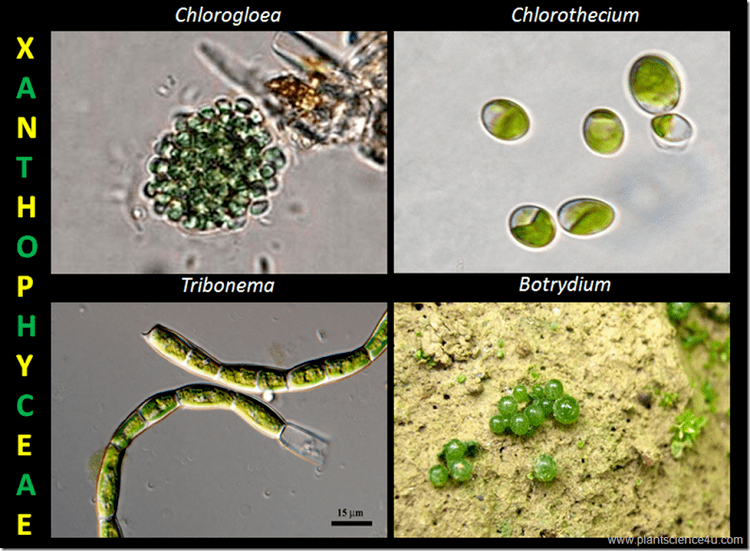Domain Eukaryota Higher classification Heterokont | Superphylum Heterokonta Rank Class | |
 | ||
Similar Golden algae, Vaucheria, Chrysophyta, Heterokont, Cryptomonad | ||
Vaucheria filamentous yellow green algae cytoplasmic streaming
Yellow-green algae or the Xanthophyceae (xanthophytes) are an important group of heterokont algae. Most live in fresh water, but some are found in marine and soil habitats. They vary from single-celled flagellates to simple colonial and filamentous forms. Xanthophyte chloroplasts contain the photosynthetic pigments chlorophyll a, chlorophyll c, β-carotene, and the carotenoid diadinoxanthin. Unlike other heterokonts, their chloroplasts do not contain fucoxanthin, which accounts for their lighter colour. Their storage polysaccharide is chrysolaminarin. Xanthophyte cell walls are produced of cellulose and hemicellulose. They appear to be the closest relatives of the brown algae.
Contents
- Vaucheria filamentous yellow green algae cytoplasmic streaming
- Classifications
- Lther 1899
- Pascher 1912
- Fritsch 1935
- Smith 1938
- Pascher 1939
- Copeland 1956
- Ettl 1978 van den Hoek et al 1995
- Maistro et al 2009
- Adl et al 2005 2012
- References
Classifications
The species now placed in the Xanthophyceae were formerly included in the Chlorophyceae. In 1899, Luther created the group Heterokontae for green algae with unequal flagella. Pascher (1914) included the Heterokontae in the Chrysophyta. In 1930, Allorge renamed the group as Xanthophyceae.
The monadoid (unicellular flagellates) and also sometimes the amoeboid species have been included by some authors in the Protozoa or Protista, as order Heterochloridina (e.g., Doflein and Reichenow, 1927-1929), as class Xanthomonadina, with orders Heterochloridea and Rhizochloridea (e.g., Deflandre, 1956), as order Heterochlorida (e.g., Hall, 1953, Honigberg et al., 1964), as order Heteromonadida (e.g., Leedale, 1983), or as subclass Heterochloridia (e.g., Puytorac et al., 1987). These groups are called ambiregnal protists, as names for these have been published under either or both of the ICZN and the ICN.
Xanthophyceae have been divided into the following four orders in some classification systems:
Lüther (1899)
Classification according to Lüther (1899):
Pascher (1912)
Classification according to Pascher (1912):
Fritsch (1935)
Fritsch (1935) recognizes the following orders in the class Xanthophyceae:
Smith (1938)
In the classification of Smith (1938), there are six orders in the class Xanthophyceae, placed in the division Chrysophyta:
Pascher (1939)
Pascher (1939) recognizes 6 classes in Heterokontae:
Copeland (1956)
Copeland (1956) treated the group as order Vaucheriacea:
Ettl (1978), van den Hoek et al. (1995)
In a classification presented by van den Hoek, Mann and Jahns (1995), based on the level of organization of the thallus, there are seven orders:
These are the same orders of the classification of Ettl (1978), an updated version of the classic work by Pascher (1939). Ultrastructural and molecular studies shows that the Mischococcales might be paraphyletic, and the Tribonematales and Botrydiales polyphyletic, and suggests two orders at most be used until the relationships within the division are sorted.
Maistro et al. (2009)
Informal groups, according to Maistro et al. (2009):
Unicellular flagellates, amoeboid and palmelloid taxa were not included in this study.
Adl et al. (2005, 2012)
According to Adl et al. (2005, 2012):
